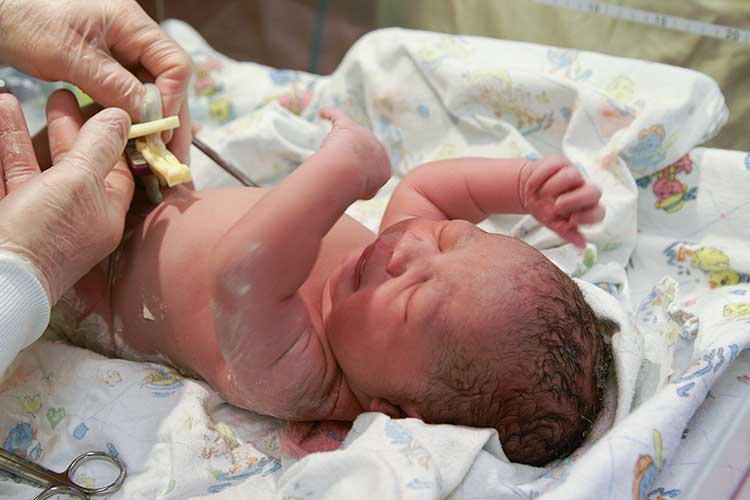Until recently, clamping and cutting the umbilical cord immediately after birth (within 30 seconds) was considered to be standard practice to allow urgent medical care to be given (The University of Sydney 2023).
Today, however, following extensive research, the practice of immediate clamping has largely been replaced by delayed cord clamping (DCC), which has been shown to have significant benefits for the infant and is now recommended in most circumstances (The University of Sydney 2023; Tommy’s 2023).
What is Cord Clamping?
After birth, the placenta continues to pulsate and transfers blood, oxygen and stem cells to the infant (Tommy’s 2023).
Cord clamping is the process of binding the umbilical cord using a nipper, which restricts blood flow between the infant and the placenta. The umbilical cord is then cut (De Bernando 2021).
In delayed cord clamping (DCC), rather than clamping the cord immediately after birth, the midwife waits until the cord has stopped pulsating before clamping it (Tommy’s 2023).
The National Institute for Health and Care Excellence (2017) recommends that cord clamping occurs no earlier than one minute following birth unless there are concerns about the cord’s integrity of the infant’s heartbeat.
The Australian and New Zealand Committee on Resuscitation (2021), on the other hand, recommends that cord clamping be delayed for at least 30 seconds in most cases.
Furthermore, recent Australian research suggests that delaying cord clamping by at least two minutes may reduce the risk of death in premature infants (The University of Sydney 2023).
Note that the cord should ideally be clamped within five minutes (Tommy’s 2023).

Benefits of Delayed Cord Clamping
Research has found a variety of benefits of DCC for infants. These include:
- Reduced risk of childhood mortality or major disability
- Reduced risk of the infant requiring a blood transfusion after birth
- Reduced risk of iron deficiency
- Increased iron levels until the age of six months, allowing for optimal physical and emotional development
- Increased stem cell levels, which assists the immune system
- Higher haemoglobin concentration
- Greater vascular stability.
(The University of Sydney 2021; NICE 2017; Tommy’s 2023)
Contraindications for Delayed Cord Clamping
Situations where delayed cord clamping may not be appropriate include:
- Where the birthing person is experiencing heavy bleeding and requires immediate medical treatment
- Placental issues such as placental abruption, low-lying placenta, placenta praevia or vasa praevia
- Where the cord is bleeding (and thus preventing blood from reaching the infant)
- Where the infant requires resuscitation (however, there is insufficient evidence on this topic)
- Multiple pregnancy where the infants share the same placenta (monochorionic pregnancy).
(Tommy’s 2023; ANZCOR 2021)

Umbilical Cord Milking
Umbilical cord milking (UCM) is performed by gently grasping the uncut umbilical cord and squeezing several times from the placenta towards the infant to provide a placental transfusion (Tommy’s 2023).
At this stage, there is insufficient evidence on the benefits of cord milking. ANZCOR (2021) advises against intact cord milking for infants < 28+0 weeks gestational age.
Conclusion
Despite immediate clamping of the umbilical cord being standard practice until recent years, delayed cord clamping is now routine and is recommended for most births due to its numerous benefits.
Test Your Knowledge
Question 1 of 3
According to the National Institute for Health and Care Excellence (NICE), when should cord clamping occur in most cases?
Topics
References
- Australian and New Zealand Committee on Resuscitation 2021, Guideline 13.1 – Introduction to Resuscitation of the Newborn, ANZCOR, viewed 21 February 2025, https://www.anzcor.org/home/neonatal-resuscitation/guideline-13-1-introduction-to-resuscitation-of-the-newborn/
- De Bernando, G 2021, Umbilical Cord Clamping: What Are the Benefits, US National Library of Medicine, viewed 21 February 2025, https://clinicaltrials.gov/ct2/show/NCT03878602
- National Institute for Health and Care Excellence 2017, Quality Statement 6: Delayed Cord Clamping, NICE, viewed 21 February 2025, https://www.nice.org.uk/guidance/qs105/chapter/quality-statement-6-delayed-cord-clamping
- Tommy’s 2023, Delayed (Optimal) Cord Clamping, Tommy’s, viewed 20 February 2025, https://www.tommys.org/pregnancy-information/giving-birth/delayed-cord-clamping-optimal
- The University of Sydney 2021, ‘Two-Year Follow Up Shows Delaying Umbilical Cord Clamping Saves Babies' Lives’, The University of Sydney, 9 December, viewed 21 February 2025, https://www.sydney.edu.au/news-opinion/news/2021/12/09/two-year-follow-up-shows-delaying-umbilical-cord-clamping-saves-.html
- The University of Sydney 2023, ‘Delaying Cord Clamping Could Halve Risk of Death in Premature Babies’, The University of Sydney News, 15 November, viewed 20 February 2025, https://www.sydney.edu.au/news-opinion/news/2023/11/15/cord-clamp-delay-could-halve-risk-of-death-in-premature-babies.html
 New
New 
